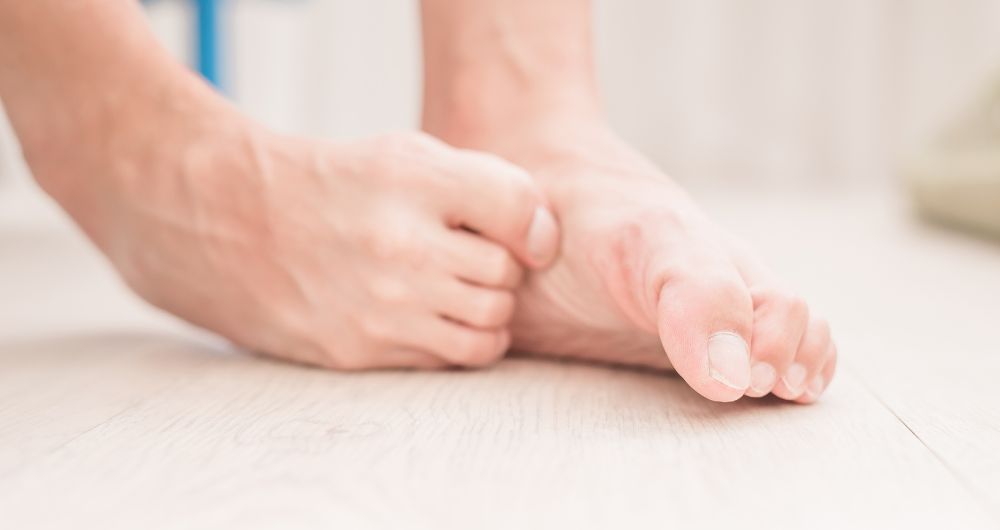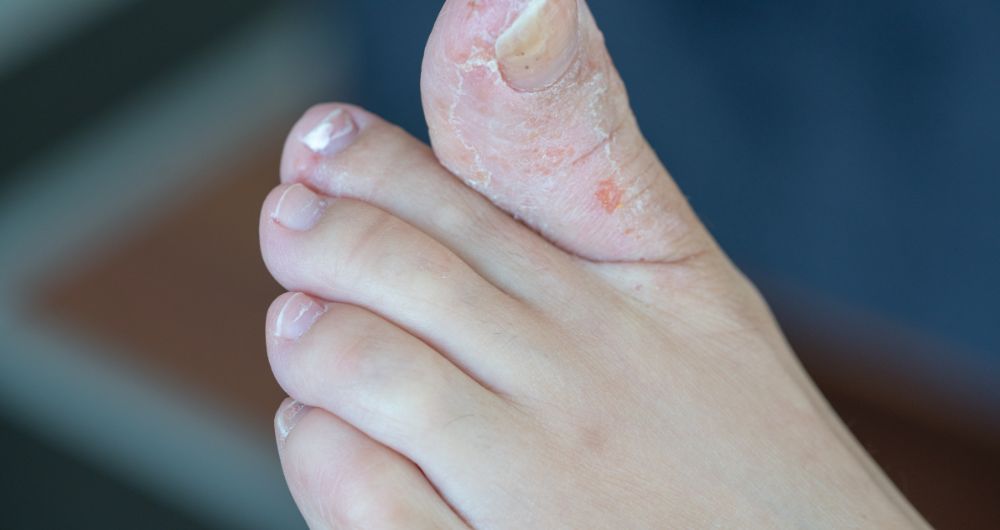
Athlete’s Foot is a common fungal infection that affects millions of people each year. While it’s often not a serious medical condition, it can be uncomfortable and frustrating. Most cases of Athlete’s Foot can be managed at home with over-the-counter treatments and proper foot hygiene. However, there are situations when seeking urgent care becomes necessary. Join us on an immersive journey as we navigate the intricate landscape of Athlete’s Foot in this in-depth guide, discussing its causes, symptoms, treatment options, and, most importantly, when to see an urgent care doctor for Athlete’s Foot.
Athlete’s Foot, scientifically known as tinea pedis, is a prevalent dermatophytic fungal infection causing significant discomfort and inconvenience. While its name may suggest it exclusively affects athletes, the truth is that anyone can fall victim to this condition, and its contagious nature makes it a concern for everyone. In this section, we’ll explore this condition in depth, covering its causes, symptoms, and potential consequences, emphasizing the importance of timely intervention and the circumstances that might necessitate seeking an urgent care doctor for Athlete’s Foot.
Athlete’s Foot is primarily caused by fungi, with Trichophyton being one of the primary culprits. These microscopic organisms thrive in warm, moist environments, making locker rooms, swimming pools, and communal showers their ideal breeding grounds. These fungi can survive on floors, towels, and footwear, waiting to latch onto unsuspecting feet.
Contrary to its name, Athlete’s Foot doesn’t discriminate based on one’s athleticism or physical activity. This fungal infection can affect anyone, regardless of their fitness level or lifestyle. The ease with which it spreads and its ability to thrive in various environments means that virtually anyone can grapple with this common ailment.
Athlete’s Foot typically begins between the toes, particularly in the spaces separating the digits. However, it doesn’t stop there; if left unchecked, it can quickly advance to other parts of the foot, including the soles and sides. As the infection progresses, it often ushers in many bothersome and uncomfortable symptoms.
The most common symptoms of Athlete’s Foot include:
While Athlete’s Foot is not life-threatening, its impact on your daily life can be significant. Left untreated, it can persist for weeks or months, causing constant discomfort and frustration. The longer it lingers, the greater the risk of complications and further spread.

Maintaining excellent foot hygiene is paramount when managing and preventing Athlete’s Foot. The steps you take to care for your feet can significantly impact your susceptibility to this fungal infection.

When faced with a mild case of Athlete’s Foot, the good news is that effective over-the-counter (OTC) treatments are readily available. These products can provide much-needed relief from the uncomfortable symptoms and help eliminate the fungal infection causing the condition.
When browsing the vast array of OTC options, it’s essential to identify products containing specific active ingredients that are effective against Athlete’s Foot. Look out for these key components:
To maximize the effectiveness of your chosen OTC treatment, it’s essential to follow best practices:
Disclaimer: While over-the-counter (OTC) treatments are effective for mild cases of Athlete’s Foot, it’s crucial to recognize that not all situations can be resolved with OTC products. If your condition worsens or persists, or you have concerns about the effectiveness of self-treatment, it is highly advisable to seek consultation with a doctor at urgent care in Bridgeport, CT. They can evaluate your condition professionally and recommend appropriate treatments to ensure your foot health. Your well-being is our top priority, and timely medical attention is sometimes essential. |

When you feel severe pain, particularly when walking or standing, it might mean your Athlete’s Foot has progressed to a more advanced stage, leading to a secondary bacterial infection. This high level of discomfort should not be ignored and calls for immediate medical attention.
Watch for signs that your Athlete’s Foot may have become infected. If the affected area swells, feels warm to the touch, and starts producing pus, it could indicate the presence of a bacterial infection. This serious development demands prompt medical evaluation to ensure proper treatment and prevent further complications.
For those living with diabetes or having weakened immune systems, Athlete’s Foot can present more significant challenges. This is because these conditions compromise the body’s ability to fend off infections effectively. Athlete’s Foot, when left unchecked in such individuals, can penetrate deeper into the layers of the skin, making it tougher to treat.
Given these heightened risks, it becomes paramount for individuals with diabetes or compromised immune systems to seek medical attention when dealing with Athlete’s Foot promptly. Early intervention can prevent the infection from becoming more severe, potentially leading to more complicated issues.
While over-the-counter (OTC) antifungal products are generally safe and effective, there’s a possibility of experiencing an allergic reaction to these treatments. This is a rare but serious occurrence. You must act swiftly if you notice hives (itchy, raised welts on the skin), severe itching, swelling, or difficulty breathing after using OTC antifungal medications.
These symptoms could indicate an allergic reaction that requires immediate medical attention. Seeking help promptly is crucial to manage the allergic reaction and avoid potential complications effectively. In such cases, your health and well-being take precedence, and professional medical assistance is the best course of action.
When seeking medical attention for Athlete’s Foot, choosing between visiting an urgent care facility like DOCS Medical Group or heading to the emergency room (ER) is vital. Understanding the distinction between the two can save you time, money, and resources. Here, we clarify when opting for urgent care over the ER is appropriate.
Urgent care centers are well-equipped to handle non-life-threatening medical issues, including severe cases of Athlete’s Foot. If you’re dealing with intense pain, discomfort, or signs of infection related to Athlete’s Foot but your overall health is stable, urgent care in Bridgeport, CT, is a suitable choice.
On the other hand, the emergency room is designed for immediate, life-threatening situations. If you experience severe difficulty breathing, chest pain, or uncontrolled bleeding unrelated to Athlete’s Foot, it’s crucial to head to the ER immediately.
Urgent care centers provide numerous advantages for individuals seeking medical attention for conditions like severe Athlete’s Foot. These benefits include:
One of the primary advantages of urgent care centers is their ability to offer shorter wait times than emergency rooms. While ERs prioritize life-threatening cases, urgent care centers cater to patients with urgent but non-critical conditions. This means you can often receive timely care without the extended waiting typically associated with emergency room visits.
Urgent care centers are generally more cost-effective than emergency room visits. This cost efficiency can be particularly beneficial for individuals dealing with conditions like severe Athlete’s Foot that do not necessitate the resources of an emergency room. Choosing an urgent care facility can help you avoid the high ER care expenses.
Urgent care centers are well-equipped to provide specialized care for conditions requiring prompt attention but not life-threatening. Severe Athlete’s Foot falls into this category. By seeking treatment at an urgent care facility, you can access healthcare professionals skilled in managing urgent conditions, including fungal infections, ensuring appropriate care.
While urgent care visits are generally cost-effective, it’s essential to consider potential expenses and financial aspects when seeking treatment for Athlete’s Foot. Here are some key considerations:
Check with your insurance provider to understand your coverage for urgent care visits. This will help you determine your potential out-of-pocket expenses and ensure you’re aware of any copayments or deductibles that may apply.
Urgent care visits are often more affordable than emergency room visits. However, assessing your financial situation and choosing the option that aligns with your budget while ensuring you receive the necessary medical care is crucial.

When you decide to visit an urgent care center to treat your Athlete’s Foot, it’s helpful to understand what the process entails. Here’s a breakdown of what you can expect during your visit:
Upon your arrival at the urgent care center, you can anticipate the following steps as part of the evaluation process:
In some instances, the urgent care doctor may deem it necessary to conduct diagnostic tests to confirm the presence of the fungal infection and determine the most appropriate treatment plan. These tests can include:
Based on the severity of your Athlete’s Foot, the urgent care doctor will devise a tailored treatment plan. Common treatment options include:
Athlete’s Foot is a manageable condition that, when addressed promptly, often responds well to self-care measures. However, there are instances where the severity of the condition or specific risk factors may call for a visit to an urgent care doctor for Athlete’s Foot. At DOCS Medical Group, we emphasize recognizing the signs, understanding the risk factors, and knowing when to seek professional medical attention.
By being aware of the symptoms, you can take proactive steps towards timely treatment. This not only helps in minimizing discomfort but also plays a pivotal role in maintaining optimal foot health.
If you ever find yourself concerned about the severity of your Athlete’s Foot or if you fall into a high-risk category, our team at DOCS Medical Group is here to assist you. We have the expertise and resources to evaluate your condition, provide appropriate treatment, and offer foot care and prevention guidance. Don’t hesitate to contact us; your feet will thank you.


During this surge in COVID-19 cases, our primary focus is meeting the high demand for tests, and we are seeing higher than usual wait times. This means we are unable to answer most phone calls. Please know that our teams are working very hard during this time to care for as many patients as safely as possible. Please click the button below for answers to common questions. We appreciate your understanding.